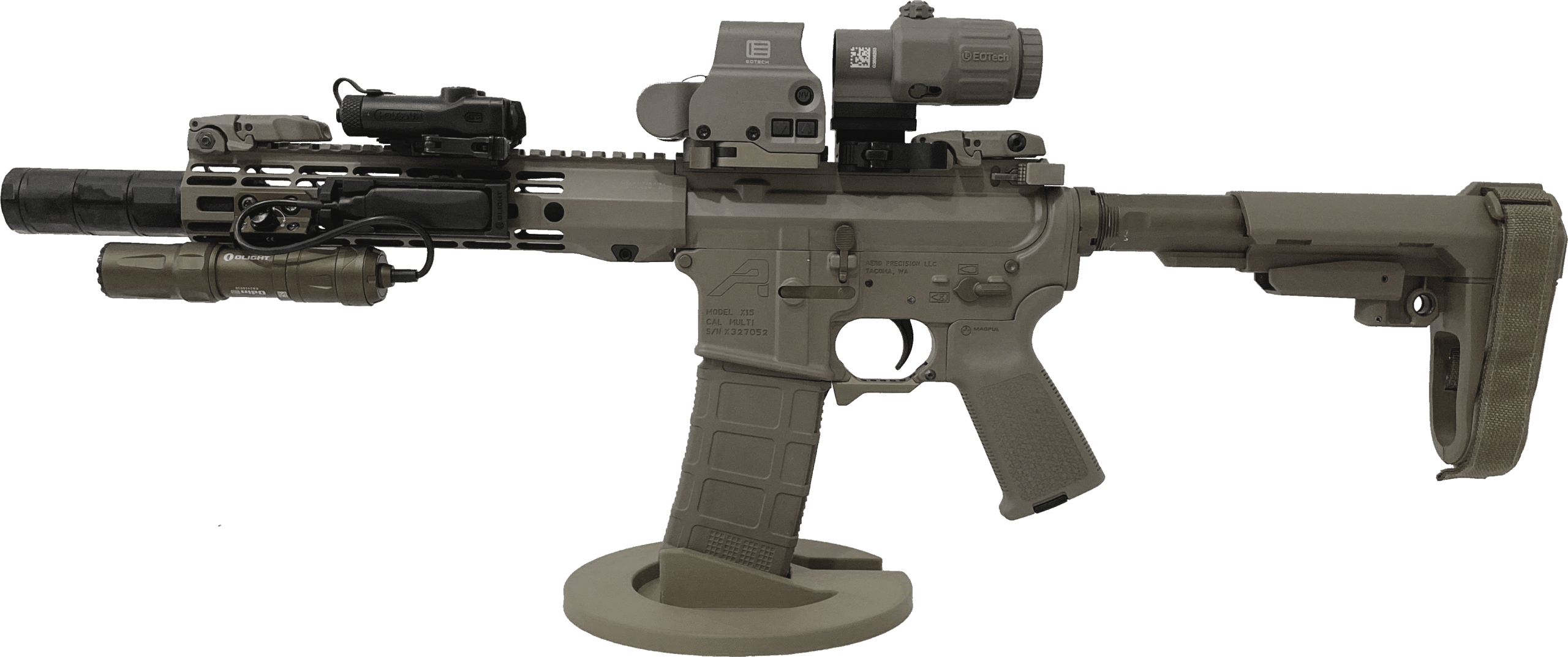


Free Shipping | 99% of all stands ship within 24 hours
We appreciate you sharing this:


We appreciate you sharing this:

Categories:
When it comes to owning an AR-15 rifle, understanding the various magazine types and their capacities is crucial for any responsible gun owner. The AR-15 platform has gained immense popularity due to its versatility, reliability, and ease of customization. However, with so many options available in the market, it can be overwhelming to choose the right magazine for your needs.
AR-15 magazines are essential components that hold and feed ammunition into your gun. They come in different shapes, sizes, materials, and capacities. While some magazines are specifically designed for military or law enforcement use, others cater to sporting purposes such as hunting or competition shooting.
In this guide, we will delve into the basics of AR-15 magazines to help you make informed decisions when selecting one for your rifle. We will explore different types of magazines commonly available on the market today and discuss their advantages and disadvantages.
Understanding magazine capacity is also critical as it determines how many rounds you can fire before needing to reload. Magazine capacity varies depending on local laws and regulations; therefore, it is vital to be aware of these restrictions in your area.
By familiarizing yourself with the basics of AR-15 magazines and their various characteristics, you will gain a better understanding of which magazine type suits your specific shooting requirements while ensuring compliance with local regulations.
When it comes to AR-15 magazines, there is a wide range of options available to suit the needs and preferences of different shooters. Understanding the different types and their features can help you make an informed decision. 1. Standard Capacity Magazines: These are the most common type, typically holding 30 rounds of ammunition. They offer a balanced capacity for various shooting applications, making them suitable for both recreational shooting and self-defense purposes.
2. Extended Capacity Magazines: Designed for those who require more rounds without frequent reloading, extended capacity magazines can hold up to 40 or even 60 rounds. They are often used by competitive shooters or in situations where continuous fire is necessary. 3. Low-Capacity Magazines: With a reduced round count, usually ranging from 5 to 10 rounds, these magazines are popular in states with restrictive gun laws or for hunting purposes where limited capacity may be required by law.
4. Drum Magazines: These cylindrical-shaped magazines have a high round count, often exceeding 50 rounds and sometimes even reaching up to 100 rounds. Drum magazines provide extended firepower but may be bulkier and less ergonomic compared to other types. 5.
When it comes to standard capacity AR-15 magazines, there are several options available in the market today. Understanding these options is crucial for any gun enthusiast or owner.
One of the most popular choices is the 30-round magazine. These magazines have been widely used and accepted as the standard capacity for AR-15 rifles. They strike a balance between providing ample firepower and maintaining maneuverability. The 30-round capacity allows for sustained fire without frequent reloading, making them ideal for self-defense or tactical situations.
For those seeking a more compact option, there are also 20-round magazines available. These shorter magazines offer increased maneuverability, making them suitable for close-quarters combat or situations that demand a lighter loadout.
On the other hand, some shooters prefer extended capacity magazines like the 40 or even 60-round variants. These high-capacity options are particularly useful in scenarios that require prolonged periods of continuous fire or when dealing with multiple targets without having to reload frequently.
It’s important to note that laws and regulations regarding magazine capacities vary by jurisdiction, so it’s essential to familiarize yourself with local legislation before purchasing any specific type of magazine.
Overall, understanding the different types of standard capacity AR-15 magazines empowers gun owners to choose what best suits their needs while ensuring compliance with relevant laws and regulations in their area.
High-capacity magazines for AR-15 rifles have been a subject of debate in recent years. These magazines, typically holding 30 or more rounds, have both supporters and opponents. Understanding the pros and cons can help you form an informed opinion on their use. One of the primary advantages of high-capacity magazines is their ability to provide sustained firepower during critical situations. In a self-defense scenario or while engaging multiple targets, having more rounds readily available can be crucial.
Additionally, high-capacity magazines can save valuable time by reducing the need for frequent reloading. On the other hand, opponents argue that high-capacity magazines may contribute to increased lethality in mass shootings. Critics contend that larger magazine capacities make it easier for criminals to inflict significant harm within short periods. Furthermore, reloading pauses often give law enforcement officers or armed citizens an opportunity to intervene during active shooter situations.
Another drawback associated with high-capacity magazines is their weight and bulkiness. These factors can make handling the rifle more challenging, especially during extended periods of use or when maneuvering in confined spaces. It is essential to note that laws regarding high-capacity magazines vary across jurisdictions. While legal in some areas, they may be restricted or banned altogether in others due to concerns over public safety.
When it comes to AR-15 magazine types and capacity, it is crucial to be aware of the state and local laws that govern their use. These laws can vary significantly from one jurisdiction to another, so understanding them is essential for responsible gun ownership. In some states, there are no restrictions on magazine capacity, allowing gun enthusiasts to choose magazines with higher capacities without legal repercussions.
However, many states have enacted laws that limit the number of rounds a magazine can hold. These restrictions typically range from 10 to 30 rounds, but they can vary even within a single state. It is important to note that while federal law does not explicitly regulate magazine capacity for most guns, individual states have the authority to establish their own regulations.
This means that what may be legal in one state could be illegal just across the border. To ensure compliance with state and local regulations, gun owners should thoroughly research the laws specific to their area before purchasing or using AR-15 magazines. Ignorance of these laws is not a valid defense if found in violation. Additionally, it is crucial for gun owners who frequently travel with their AR-15 rifles or magazines to familiarize themselves with the laws of any jurisdiction they may enter.
Many states have strict penalties for individuals caught in possession of magazines with capacities exceeding legal limits.
When it comes to selecting the right magazine capacity for your AR-15, it’s important to consider your specific requirements and intended use. While higher capacity magazines may offer more rounds before needing to reload, they also come with certain drawbacks. Here are a few factors to keep in mind when making your decision:
1. Purpose: Determine the primary purpose of your AR-15. Are you using it for self-defense, competitive shooting, or hunting? For self-defense or home protection, a standard capacity magazine (typically 30 rounds) may be sufficient. However, if you participate in competitive shooting or plan on using your rifle for longer-range engagements while hunting, you might consider larger-capacity magazines. 2. Weight and Maneuverability: Higher-capacity magazines tend to be bulkier and heavier compared to their standard counterparts.
If you value maneuverability and quick target transitions, opting for lighter magazines with lower capacities could be advantageous. 3. Legal Restrictions: Be aware of local laws regarding magazine capacities as some jurisdictions impose limits on how many rounds a magazine can hold. 4. Reloading Frequency: Consider how frequently you are comfortable with reloading during shooting sessions. Smaller capacity magazines may require more frequent reloads but can also provide an opportunity for skill-building and better weapon manipulation under pressure.
For AR-15 enthusiasts looking to enhance their shooting experience, upgrading the magazine capacity is a popular choice. While standard magazines typically hold around 30 rounds, there are aftermarket options available that can significantly increase your gun’s ammunition capacity. One of the most common ways to upgrade your AR-15’s magazine capacity is by utilizing extended magazines. These magazines are designed to hold more rounds than their standard counterparts, often ranging from 40 to 60 rounds.
By increasing the number of bullets you can load into a single magazine, extended magazines reduce the need for frequent reloads during intense shooting sessions. Another option for expanding magazine capacity is drum magazines. These cylindrical-shaped devices can store even more rounds than extended magazines, with capacities ranging from 50 to over 100 rounds. Drum magazines offer an advantage in scenarios where sustained firepower or prolonged shooting sessions are required, such as in competitive shooting or tactical situations.
It’s important to note that while extended and drum magazines provide increased ammunition capacity, they also add weight and bulkiness to your gun. This may affect maneuverability and handling, particularly in close-quarters or dynamic shooting environments. Before purchasing any aftermarket magazine options, it is crucial to ensure compatibility with your specific AR-15 model and caliber.
Properly maintaining and caring for your AR-15 magazines is essential to ensure their longevity, reliability, and optimal performance. Regular maintenance not only extends the life of the magazines but also enhances their overall functionality. Here are some crucial tips to help you keep your AR-15 magazines in top shape:
1. Cleaning: After each use, it is vital to clean your magazines thoroughly. Disassemble them carefully, removing any dirt, debris, or residue that may have accumulated inside. Use a soft brush or toothbrush along with a mild cleaning solvent to scrub the interior and exterior surfaces. 2. Lubrication: Apply a thin coat of lubricant on the magazine’s moving parts such as the follower and spring.
This helps reduce friction and ensures smooth operation during loading and feeding. 3. Inspection: Regularly inspect your magazines for signs of wear or damage, especially around feed lips, followers, and springs. Bent feed lips or weak springs can cause feeding issues and potentially lead to malfunctions. 4. Storage: Properly store your AR-15 magazines in a dry environment away from extreme temperatures or humidity levels that could potentially damage them over time.
5. Rotate Magazines: If you regularly use multiple AR-15 magazines, it is advisable to rotate their usage periodically instead of relying solely on one magazine consistently.
When it comes to selecting the right AR-15 magazine type and capacity, it is crucial to consider various factors that align with your specific needs and intended usage. While high-capacity magazines may offer extended shooting sessions without reloading, they also come with potential drawbacks such as increased weight and decreased maneuverability. On the other hand, low-capacity magazines may be more suitable for certain scenarios where discretion or ease of handling is paramount.
Understanding the legal restrictions in your jurisdiction is of utmost importance. Ensure you are aware of any state or local laws governing magazine capacity limits, as non-compliance can lead to serious legal consequences. Additionally, consider the purpose for which you intend to use your AR-15. If you primarily engage in recreational shooting or target practice, a standard capacity magazine may suffice.
However, if self-defense or competitive shooting is your focus, higher-capacity options could prove beneficial. Evaluating reliability and durability should also be a priority when choosing AR-15 magazines. Look for reputable manufacturers known for producing reliable products that can withstand rigorous use without compromising performance. Ultimately, making an informed decision about AR-15 magazine types and capacities requires careful consideration of legalities, individual needs, intended usage scenarios, reliability factors, and personal preferences.